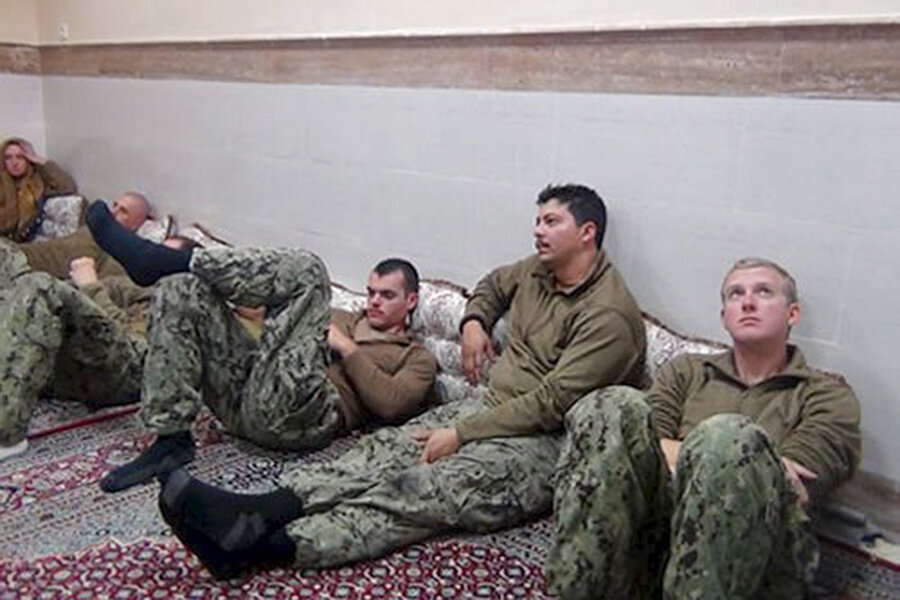US sailors freed: With nuclear deal close, Iran skirts boat-loads of trouble
| Istanbul, Turkey
Putting a quick end to an incident that could easily have escalated, Iran has released 10 US Navy sailors and their two boats that it had detained overnight in its territorial waters.
Swift diplomacy on the eve of implementing the landmark nuclear deal agreed to last July between Iran and world powers helped defuse the crisis. That included direct contact between top diplomats of both countries via channels that were pioneered during years of nuclear talks.
The Pentagon said the sailors were released Wednesday unharmed and that it “will investigate the circumstances that led to the sailors’ presence in Iran.”
Iran appeared determined not to let spoilers jeopardize the nuclear deal.
“Clearly, for the moment at least, the regime is in a pragmatic mood. They don’t want to spoil the implementation of the agreement,” says Shahram Chubin, an Iran specialist with the Carnegie Endowment for International Peace in Geneva.
The speedy decision may also indicate a desire to avoid a lengthy and potentially damaging debate inside Iran about the US and the nuclear deal, which has been decried by hardliners, just weeks before parliamentary elections on Feb. 26.
“Normally there would be a factional tug-of-war, and somebody stopped it,” says Mr. Chubin, noting that Iran’s supreme leader, Ayatollah Ali Khamenei, almost certainly played a role.
“I don’t know who it favors, but it suggests that Khamenei is still on board, feeling pragmatic. Despite what he says, which is very hard-line, he’s practical,” Chubin says. “The subtext of all that is people’s expectations – they want the situation to improve.”
Initial allegations of 'snooping'
Initial Iranian reports said the US sailors had been “snooping” three miles inside Iranian waters when they were apprehended and taken to Farsi Island, site of a base of the Islamic Revolutionary Guard Corps (IRGC) in the Persian Gulf.
Video footage showed the moments of arrest, with the Americans on board their craft, on their knees and hands behind their heads, as well as Iranians laying out their weaponry. Images also showed the Americans during their detention, wearing their camouflage uniforms with shoes off, sitting on cushions and Persian carpets, and eating a meal.
In a statement announcing the release Wednesday, the IRGC said the Americans – nine men and a woman – had strayed unintentionally into Iranian waters, and that the US had apologized and had “undertaken not to repeat such mistakes.”
The speedy resolution was a surprise to many in the flashpoint Persian Gulf, where the US Navy’s Fifth Fleet patrols waters just off Iran’s southern, 1,100-mile-long coastline. A long history of saber-rattling and heated rhetoric – often about choking off global oil flows through the Strait of Hormuz – has made miscalculation a chronic concern.
In 2007, Iran held 15 British sailors it seized in Iraqi waters for 13 days. And in 2004, eight Royal Navy sailors were held for two days and released – but not before they were paraded blindfolded on state TV.
In past incidents “there has been a lot of grandstanding,” says Chubin. “You wouldn’t have expected this. It’s quite a striking change.”
Despite the nuclear deal, tough talk and actions have hardly eased. Last February during military exercises, Iranian forces targeted a large mock-up of a US aircraft carrier. And last month, in a show of force that the US military called “highly provocative,” Iranian ships fired rockets just 1,500 yards from the carrier USS Harry Truman. Iran denies the incident; the Pentagon released video footage of it this week.
But when American sailors actually arrived in Iranian waters, aboard two riverine command boats apparently experiencing mechanical or navigational difficulties, the decision was made in Tehran not to escalate.
The new normal?
US Secretary of State John Kerry called his Iranian counterpart, Mohammad Javad Zarif, immediately after the American sailors were first picked up. On Wednesday, Mr. Kerry thanked Iranian authorities for their swift “cooperation.” That it was “resolved peacefully and efficiently is a testament to the critical role diplomacy plays in keeping our country safe, secure, and strong,” he said in a statement.
Mr. Zarif tweeted: “Happy to see dialog and respect, not threat and impetuousness, swiftly resolved the #sailors episode. Let’s learn from this latest example.”
“It was a serious incident. If it had happened two years ago, it would have been impossible for us to see these sailors released by the IRGC,” the conservative political analyst Ghanbar Naderi told Al Jazeera English from Tehran.
“But now that we have adopted some dialogue and cooperation policy with the United States, especially after the nuclear deal … it just came as natural,” said Mr. Naderi.
“We know that over the next few days the [nuclear] deal is going to be fully implemented … and for the time being Iranian officials, the Iranian armed forces, especially the IRGC commanders, don’t want to take any unnecessary risk.”






